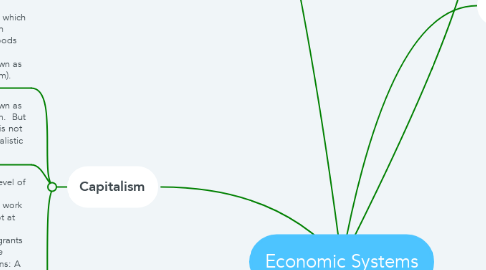Economic Systems
by dolores scisney

1. Communism
1.1. Communism, a political and economic doctrine whose the goal is to replace private property and a profit-based economy with public ownership and communal control of at least the major means of production (e.g., mines, mills, and factories) and the natural resources of a society. In countries that practice communism, a political, and economic doctrine designed to replace private property and a profit-based economy with public ownership and communal control of at least the major means of production (e.g., mines, mills, and factories)and the natural resources of society(Britannica.com).
1.2. Two of the major examples of Communism, or a communist economy, are China and Cuba. China officially called the People's Republic of China is ruled by a single party, the Communist Party of China. In China's communist economy, there are some business entities that operate semi-autonomously – such as online e_-_commerce giant Alibaba Group Holding Limited – but the state still controls the vast majority of the "means of production" as Marx would have termed it. Cuba, in a similar fashion, is officially known as the Republic of Cuba, is a communist economy and communist political system, but over the past few years, the government gradually loosened its tight restrictions on foreign travel and also began allowing some private economic activity among its citizens (Teemboom, 2018).
1.3. Pros: Communism has a centrally planned economy. It can quickly mobilize economic resources on a large scale. It is able to execute massive projects and create industrial power. Cons: he most significant disadvantage of communism stems from its elimination of the free market.
2. Socialism
2.1. Socialism is a populist economic and political system based on public ownership (also known as collective or common ownership) of the means of production. Those means include the machinery, tools, and factories used to produce goods that aim to directly satisfy human needs (Investopedia.com).
2.2. The former Soviet Union is an example of a socialist system. Cuba is an example of a socialist nation. Its economy is state run and it lacks a stock exchange. ... The country of North Korea is a socialist state, lacking a stock exchange, supporting many social programs, and the economy is state-run (Your dictionary.com).
2.3. Pros: Socialism creates a system without classes. Socialism eliminates economic gaps and creates balance and improves standard of living. Socialism also encourages skill enhancement. Each person in the society is expected to contribute their skills for the overall betterment of society. Cons: Socialism in its true form has not been implemented. In a real socialistic society one person is designated to distribute resources to all and this gives the perception and power of a dictator or a communistic society. A striking characteristic of socialism is the reduction of the workforce. . It is said that socialism promotes laziness because if people know they can collect a benefit without working then they won’t, and this negatively impacts the economic growth (Ayres, 2019).
3. United States Economic System
3.1. The United States has a mixed economy. It works according to an economic system that features characteristics of both capitalism and socialism. A mixed economic system protects private property and allows a level of economic freedom in the use of capital, but also allows for governments to intervene in economic activities in order to achieve social aims and for the public good (Ross, 2018).
4. Why Important to have Economic System
4.1. Economic systems are the means by which countries and governments distribute resources and trade goods and services. They are used to control the five factors of production, including: labor, capital, entrepreneurs, physical resources and information resources (study.com).
5. Capitalism
5.1. Capitalism is an economic system in which private individuals or businesses own capital goods. The production of goods and services is based on supply and demand in the general market—known as a Market Economy (Investopedia.com).
5.2. The United States for most is known as the premier example of Capitalism. But it is a known fact that there really is not a country that runs on a true capitalistic economy.
5.3. Pros: Capitalism affords everyone a level of control over their life. In a capitalistic society a person can own a business, work for an employer as a freelancer, or not at all. One of the well-known pros of capitalism is innovation. Capitalism grants its people political freedom and more importantly economic freedom. Cons: A less attractive feature of capitalism is equal opportunity for employees. If it weren’t for government regulations only those with direct access to opportunities would advance. Capitalism puts its focus on able-bodied employees. The worst part of capitalism is that there is no incentive to fairly compensate employees (Ayres, 2019).
6. References
6.1. Teemboom, L. (2018). Economic Systems of Communism. Retrieved from: https://smallbusiness.chron.com/economic-system-communism-5193.html
6.2. Britannica. (2019). Retrieved from: communism | Definition, Facts, & History
6.3. Investopedia. (2019). Retrieved from: Investopedia.com.
6.4. Your Dictionary. (2019). Retrieved from: Yourdictionary.com
6.5. Ayres, C. (2019). 17 Pros and Cons of Capitalism. Retrieved from: 17 Pros and Cons of Capitalism
6.6. Ayres, C. (2019). 11 Socialism Pros and Cons List. Retrieved from: 11 Socialism Pros and Cons List
6.7. Ross, S. (2018). Is the United States a Market Economy or Mixed Economy?. Retrieved from: Is the United States a Market Economy or a Mixed Economy?
6.8. Economic Systems: Definition, Types & Examples - Video & Lesson Transcript | Study.com


